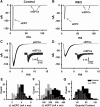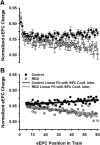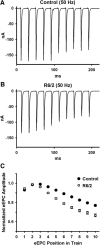Depressed Synaptic Transmission and Reduced Vesicle Release Sites in Huntington's Disease Neuromuscular Junctions
- PMID: 28724748
- PMCID: PMC5566863
- DOI: 10.1523/JNEUROSCI.0313-17.2017
Depressed Synaptic Transmission and Reduced Vesicle Release Sites in Huntington's Disease Neuromuscular Junctions
Abstract
Huntington's disease (HD) is a progressive and fatal degenerative disorder that results in debilitating cognitive and motor dysfunction. Most HD studies have focused on degeneration of the CNS. We previously discovered that skeletal muscle from transgenic R6/2 HD mice is hyperexcitable due to decreased chloride and potassium conductances. The progressive and early onset of these defects suggest a primary myopathy in HD. In this study, we examined the relationship between neuromuscular transmission and skeletal muscle hyperexcitability. We used an ex vivo preparation of the levator auris longus muscle from male and female late-stage R6/2 mice and age-matched wild-type controls. Immunostaining of the synapses and molecular analyses revealed no evidence of denervation. Physiologically, we recorded spontaneous miniature endplate currents (mEPCs) and nerve-evoked EPCs (eEPCs) under voltage-clamp, which, unlike current-clamp records, were independent of the changes in muscle membrane properties. We found a reduction in the number of vesicles released per action potential (quantal content) in R6/2 muscle, which analysis of eEPC variance and morphology indicate is caused by a reduction in the number of vesicle release sites (n) rather than a change in the probability of release (prel). Furthermore, analysis of high-frequency stimulation trains suggests an impairment in vesicle mobilization. The depressed neuromuscular transmission in R6/2 muscle may help compensate for the muscle hyperexcitability and contribute to motor impersistence.SIGNIFICANCE STATEMENT Recent evidence indicates that Huntington's disease (HD) is a multisystem disorder. Our examination of neuromuscular transmission in this study reveals defects in the motor nerve terminal that may compensate for the muscle hyperexcitability in HD. The technique we used eliminates the effects of the altered muscle membrane properties on synaptic currents and thus provides hitherto the most detailed analysis of synaptic transmission in HD. Clinically, the striking depression of neurotransmission we found may help explain the motor impersistence in HD patients. Therapies that target the highly accessible peripheral nerve and muscle system provide a promising new avenue to lessen the debilitating motor symptoms of HD.
Keywords: Huntington's disease; electrophysiology; neuromuscular transmission; synaptic transmission; trinucleotide repeat disorder.
Copyright © 2017 the authors 0270-6474/17/378077-15$15.00/0.
Figures











Similar articles
-
Progressive abnormalities in skeletal muscle and neuromuscular junctions of transgenic mice expressing the Huntington's disease mutation.Eur J Neurosci. 2004 Dec;20(11):3092-114. doi: 10.1111/j.1460-9568.2004.03783.x. Eur J Neurosci. 2004. PMID: 15579164
-
Levator Auris Longus Preparation for Examination of Mammalian Neuromuscular Transmission Under Voltage Clamp Conditions.J Vis Exp. 2018 May 5;(135):57482. doi: 10.3791/57482. J Vis Exp. 2018. PMID: 29782004 Free PMC article.
-
Progressive Cl- channel defects reveal disrupted skeletal muscle maturation in R6/2 Huntington's mice.J Gen Physiol. 2017 Jan;149(1):55-74. doi: 10.1085/jgp.201611603. Epub 2016 Nov 29. J Gen Physiol. 2017. PMID: 27899419 Free PMC article.
-
Zebrafish neuromuscular junction: The power of N.Neurosci Lett. 2019 Nov 20;713:134503. doi: 10.1016/j.neulet.2019.134503. Epub 2019 Sep 23. Neurosci Lett. 2019. PMID: 31557523 Free PMC article. Review.
-
Cholesterol and the Safety Factor for Neuromuscular Transmission.Int J Mol Sci. 2019 Feb 28;20(5):1046. doi: 10.3390/ijms20051046. Int J Mol Sci. 2019. PMID: 30823359 Free PMC article. Review.
Cited by
-
No symphony without bassoon and piccolo: changes in synaptic active zone proteins in Huntington's disease.Acta Neuropathol Commun. 2020 Jun 3;8(1):77. doi: 10.1186/s40478-020-00949-y. Acta Neuropathol Commun. 2020. PMID: 32493491 Free PMC article.
-
Abnormalities in the Motor Unit of a Fast-Twitch Lower Limb Skeletal Muscle in Huntington's Disease.ASN Neuro. 2019 Jan-Dec;11:1759091419886212. doi: 10.1177/1759091419886212. ASN Neuro. 2019. PMID: 31818120 Free PMC article.
-
A mouse model of Huntington's disease shows altered ultrastructure of transverse tubules in skeletal muscle fibers.J Gen Physiol. 2021 Apr 5;153(4):e202012637. doi: 10.1085/jgp.202012637. J Gen Physiol. 2021. PMID: 33683318 Free PMC article.
-
Huntingtin regulates calcium fluxes in skeletal muscle.J Gen Physiol. 2023 Jan 2;155(1):e202213103. doi: 10.1085/jgp.202213103. Epub 2022 Nov 21. J Gen Physiol. 2023. PMID: 36409218 Free PMC article.
-
Inferring synaptic transmission from the stochastic dynamics of the quantal content: An analytical approach.PLoS Comput Biol. 2025 May 13;21(5):e1013067. doi: 10.1371/journal.pcbi.1013067. eCollection 2025 May. PLoS Comput Biol. 2025. PMID: 40359429 Free PMC article.
References
Publication types
MeSH terms
Grants and funding
LinkOut - more resources
Full Text Sources
Other Literature Sources
Medical
Molecular Biology Databases
